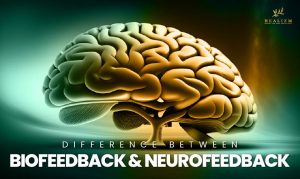
A growing number of people are turning to alternative therapies and techniques to increase their mental well-being, manage stress better, and improve their health.
Many people are using biofeedback and neurofeedback therapy and find it helpful.
While these terms may sound similar, they are distinct approaches with unique benefits and applications.
This blog post will discuss the difference between biofeedback and neurofeedback, and highlight their mechanisms, uses, and potential benefits.
What is Biofeedback?
Biofeedback is a technique that helps people gain insight and control over their physiological responses by providing real-time feedback on their bodily functions.
It measures specific parameters like heart rate, skin temperature, and muscle tension and displays them visually or audibly.
By observing these indicators, people can learn to regulate their bodily responses, promoting relaxation and well-being.
The main goal of biofeedback is to raise awareness of the body’s physiological processes, which are usually involuntary.
With instant feedback, people can consciously influence these processes.
For example, someone undergoing biofeedback therapy can learn techniques to reduce their heart rate or muscle tension, reducing stress and improving physical and mental health.
What Are the Benefits of Biofeedback and What Does It Treat?
Biofeedback has many uses and benefits, it can treat :
- Stress management and relaxation.
- Anxiety and mood disorders.
- Chronic pain management.
- Hypertension and cardiovascular health.
- Migraine and tension headache relief.
- Musculoskeletal disorders and rehabilitation.
- Enhancing performance in sports and athletics.
How Biofeedback Works
Here’s how it works step-by-step:
- Sensors Placement: Small sensors or electrodes are attached to specific body areas. These sensors measure physiological parameters like heart rate, muscle tension, and skin temperature.
- Data Collection: In real-time, the sensors send the collected data to a computer or a display monitor.
- Feedback Presentation: The data is then translated into visual or auditory signals. For instance, a rise in heart rate might be represented by an accelerating beep or a changing visual graph.
- Interpretation & Control: With the guidance of a therapist, the patient learns to interpret these signals. Over time, they can consciously influence and control their physiological responses by using relaxation techniques, deep breathing, or visualization.
- Skill Mastery: With enough practice, people can become capable of controlling specific physiological functions, even without immediate feedback from the machine.
Biofeedback Devices – Tools for Wellness
A biofeedback device is a specialized tool or equipment used to measure and provide feedback on physiological responses during biofeedback therapy.
These devices include sensors that detect specific bodily functions.
Biofeedback devices can range from simple handheld monitors to more advanced systems that integrate with computer software for data analysis and feedback presentation.
What is Biofeedback Occupational Therapy (OCT)?
Biofeedback occupational therapy combines elements of biofeedback with occupational therapy techniques.
Occupational therapy focuses on helping patients regain or develop skills necessary for daily activities and functioning.
Biofeedback is integrated into the occupational therapy process to enhance the effectiveness of treatment.
What is Neurofeedback?
Neurofeedback is a specialized form of biofeedback that focuses on monitoring and regulating brain activity.
Also known as neurotherapy or EEG involves recording electrical patterns produced by the brain and presenting them in a visual or auditory format to the person.
By receiving this feedback, people can learn to modulate their brainwaves and promote desirable patterns associated with improved cognitive function, emotional regulation, and well-being.
The primary tool used in neurofeedback is an electroencephalogram (EEG), which measures the brain’s electrical activity using electrodes placed on the scalp.
These electrodes detect brainwave patterns and translate them into meaningful feedback, enabling people to understand and influence their brain’s functioning.
What Does Neurofeedback Treat?
Neurofeedback has many benefits and is used to treat various conditions, including:
- Attention deficit hyperactivity disorder (ADHD).
- Autism spectrum disorders.
- Insomnia and sleep disorders.
- Anxiety and mood disorders.
- Traumatic brain injuries.
- Epilepsy and seizure disorders.
- Cognitive enhancement and peak performance.
The International Society for Neurofeedback & Research provides a wealth of information and studies on the benefits of neurofeedback.
How Neurofeedback Works
Here’s how it works:
- EEG Setup: Electrodes are placed on the scalp to measure brainwave activity – this is done using an electroencephalogram (EEG).
- Brainwave Monitoring: The EEG records the brain’s electrical patterns. Neurofeedback monitors five types of brainwaves — delta, theta, alpha, beta and These patterns are categorized into different frequencies, each associated with specific states of consciousness and cognitive functions.
- Real-time Feedback: The brainwave data is displayed on a screen, often in the form of a video game or visual graphics. For instance, maintaining a desired brainwave state might keep a video game character airborne.
- Brainwave Modulation: The individual learns to control or modulate their brainwave activity based on the feedback. Over time, they can stimulate brainwave patterns linked with relaxation, focus, or other desired states.
- Consistent Training: With consistent neurofeedback sessions, the brain learns to maintain these healthy states, even outside the therapy environment.
Types of Neurofeedback
Neurofeedback offers different types of training to address specific brainwave patterns and conditions.
Some common types include:
- Frequency/Power Neurofeedback.
- Slow Cortical Potential Neurofeedback (SCP-NF)
- Low-Energy Neurofeedback System (LENS)
- Hemoencephalographic (HEG) Neurofeedback.
- Live Z-score Neurofeedback.
- Low-Resolution Electromagnetic Tomography (LORE-TA)
- Functional Magnetic Resonance Imaging (fMRI).
Each type focuses on specific brainwave frequencies and seeks to improve cognitive functions or target particular disorders.
Neurological Stress Reduction Therapy and Neurofeedback – How Do They Differ?
Neurological Stress Reduction Therapy (NSRT) takes a holistic approach to stress reduction.
It acknowledges that stress can impact the body in various ways and aims to restore balance by incorporating multiple treatment methods.
Practitioners of NSRT use muscle testing, electromagnetic therapies, nutritional supplementation, lifestyle changes, and energy balancing to address stress-related factors.
In contrast, Neurofeedback focuses on training individuals to self-regulate their brainwave activity.
Difference Between Biofeedback vs Neurofeedback Therapy
While biofeedback and neurofeedback share the common goal of self-regulation, they differ in the specific physiological processes they monitor and modulate.
Biofeedback encompasses a broader range of measurements, including heart rate variability, skin conductance, and muscle tension, whereas neurofeedback focuses exclusively on brainwave activity.
Biofeedback therapy often involves sensors placed on the skin to measure physiological responses.
In contrast, neurofeedback uses EEG sensors placed on the scalp to monitor brain activity.
The feedback in biofeedback typically relates to visual or auditory cues representing the physiological measurements.
At the same time, neurofeedback specifically targets brainwave patterns, allowing people to learn how to enhance or suppress specific brainwave frequencies.
Finding a Practitioner
If you are considering biofeedback or neurofeedback therapy, finding a qualified and experienced practitioner who can guide you through the process is essential.
You can find professionals in your area by searching for “biofeedback therapist near me” or “neurofeedback therapist near me.”
They can provide personalized guidance, develop treatment plans specific to your needs, and monitor your progress carefully.
The Cost and Accessibility
Neurofeedback and biofeedback therapy costs can vary depending on where you live, the practitioner’s expertise, the length of your sessions, and how many you need.
Contact therapists in your area and inquire about their fees and available packages.
Additionally, some practitioners offer biofeedback training online, making it more accessible to those who do not have access to local providers or prefer the convenience of remote sessions.
Certification and Training
Choosing a certified professional with appropriate training and relevant credentials is essential when seeking biofeedback or neurofeedback therapy.
Look for certifications like the Biofeedback Certification International Alliance (BCIA).
Certifications ensure that the practitioner has met specific standards and has the skills to provide safe and effective care.
Biofeedback and Neurofeedback: Paths to Self-Regulation
Biofeedback and neurofeedback offer distinct paths to self-regulation and well-being.
While biofeedback focuses on monitoring various physiological responses and providing feedback, neurofeedback focuses on brainwave activity and modulation.
Both have shown effectiveness in addressing different conditions and improving health.
If you want to explore biofeedback or neurofeedback therapy, contact a qualified professional.
Whether you choose biofeedback or neurofeedback, either path allows you to understand and influence the inner workings of your mind and body.
Take the time to explore the possibilities, find a practitioner who resonates with you, and experience the healing effects of biofeedback or neurofeedback therapy.
If you want to try biofeedback or neurofeedback therapy, contact us at Healizm — we’re here to help.
